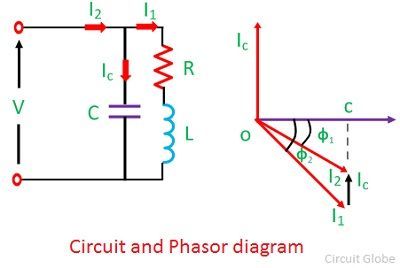Power Factor Improvement
If the power factor is low or poor, it is necessary to improve or correct it. It may be improved by injecting a leading current into the circuit so as to neutralize the effect of lagging current. The power factor may be improved by using static capacitors or synchronous motors.
Power factor correction by static capacitors
Consider an inductive load consisting of a resistor R and an inductor L connected to an AC supply. The circuit and phasor diagrams are shown in the figure.
V – supply voltage.
I1 – load current
φ1 – phase angle by which the current I1 lags behind the voltage
cosφ1 – original power factor
I1 – load current
φ1 – phase angle by which the current I1 lags behind the voltage
cosφ1 – original power factor
Let the capacitor C be placed in parallel with the load. It will take a leading current Ic from the supply. The circuit and phasor diagrams are shown in the figure.
The total I2 drawn from the supply will be equal to the phasor sum of I1 and Icthat is
 Conclusions
Conclusions
- The phase angle of I2 is φ2. It is seen from the phasor diagram that the φ2 is less than φ1, and hence, cosφ2 is greater than cosφ1. In other words, the power is improved from cosφ1 to cosφ2.
- The new current supply from the supply is less than the load current I1, i.e., I2> I1. The new current is given by the equation
- By connecting a capacitor in parallel with an inductive load, the power factor is improved, and the current from the supply is reduced without altering either current or power taken by the load.




No comments:
Post a Comment